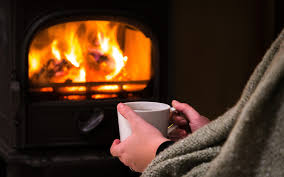NORTHERN RHODE ISLAND – In the 19th century, New Englanders on cold winter nights might gather around the hearth and read poetry.
With Rhode Island now fully in the grip of the winter season, those fortunate to have a hearth are gathering, though they’re probably not reciting the works of fireside poets.
Instead, they’re likely keeping toasty while working by the fireplace, wood stove, gas or pellet stove.
“More people are working from home, or are home more, so they have more time to use them,” said John Kopec, president of A-Tec Chimney of Cumberland.
Some locals aren’t just sitting by the hearth; they’re giving it a revamp.
“A lot of people are changing the fireplace,” said Daniel Esposito, owner of Victory Supply, LLC in Harrisville.

Currently in vogue is veneer, a thin stone. Also perennially favored is brick, Esposito says.
“We sell a lot of marble, brick – and ledge,” Esposito said, noting it’s available in an array of colors.
Kopec specializes in chimney liners, repairs, rebuilds and restoration, and also builds from scratch.
Unlike in days gone by when people were reading poetry fireside by the stone hearth, it’s “rare to run into stone today,” Kopec said, noting that stone costs more.
Popular choices instead are brick or prefab.
But, “if you plan on living somewhere a while, don’t buy prefab,” said Kopec. “Brick is more solid. If something goes wrong with prefab, it’s problematic,” potentially requiring more than one type of contractor to fix the problem.
Kopec maintains all kinds of chimneys, including some of those built in the 18th or 19th century. He notes the older works are, “a lot bigger,” than today’s, and have built in compartments with ovens in the side. Common back then was five fireplaces in one chimney.
Today, “usually the maximum you’ll see are two fireplaces, maybe three, in one chimney,” Kopec said.
That’s in part because of government regulatory codes. New England farmers in those famously frigid snow winters of past centuries weren’t consulting codes regarding keeping their families warm.
“Back then there were no code requirements,” said Kopec.
Modern dwelling codes together with maintenance is what’s expected today. How frequently maintenance is necessary depends on the type of wood burned.
“For every cord, if burning well-seasoned wood. Not well-seasoned then more often,” Kopec said.
He warned that some wood not seasoned, is sold as seasoned, and was, “just split a week ago not last year.”
How can one tell the difference?
“Seasoned wood is half the weight,” of more newly cut wood, he said. If seasoned wood, “drops on concrete it will ring and bounce, sound hollow,” and if, “not seasoned it has a heavy or thud sound.”
That’s because “seasoned has less than 20 percent moisture inside.”
Once split, “a log starts to season; water doesn’t move horizontally; it
wants to move up and down. The split starts the seasoning process,” Kopec said.
Whether do-it-yourselfers should handle chimney maintenance is a question.
“You need the right equipment,” Kopec said.
A chimney vacuum, and must be, “comfortable on your roof.”
If one is not using the right equipment this “can cause damage,
such as soot damage,” cautions Kopec. “Soot in a room can cause lots in remediation. Soot gets all over walls, carpets – anything not a solid surface.”
Creosote sweeping logs are not for cleaning the chimney but will, “help keep down the creosote.”
Kopec explains the three classifications of creosote:
“Stage one is powdery.”
At stage two the creosote “goops up, like molasses.”
Second stage creosote has also been described as crunchy-looking or black foam.
Stage three creosote resembles, “black obsidian, like black glass” – and is flammable and can cause a chimney fire. This third stage creosote is likely sticky, and stage three is the most difficult to remove, as well as the most flammable.
And at a time when homeowners are already more inclined than ever to invest in ways to enjoy their abodes, they have a new incentive to install a wood heating system.
On Monday, Dec. 28, President Donald Trump signed into law legislation described as,, “the largest renewable energy spending bill in a decade and included incentives for solar, wind, advanced wood heat and a host of other technologies.”
The new law greatly affects and was promoted by many New Englanders.
“This marks the first-time modern wood heating systems have been granted an Investment Tax Credit, rather than the far smaller tax credit wood heating technologies had been receiving,” reports Alliance for Green Heat, a non-profit organization. Moreover, “The incentive provides a 26 percent tax credit for stoves and boilers that are 75% efficiency or higher.”
That’s beneficial to keeping comfy in cold New England.
Biomass Thermal Energy Council, a group that advocates for sustainable use of wood and agricultural biomass for clean, efficient heat, began lobbying for the legislation in 2009.
BTEC provides specifics on the new law:
-The credit applies to the installed cost of home heating and hot water systems that utilize wood pellets, chips and cordwood at efficiencies greater than 75 percent high heat value.
-A federal income tax credit of 26 percent commences with systems purchased in 2021 and phases down to 22 percent in 2022 and 2023.
-A wood pellet stove that costs $4,000 to install in 2021 will realize a savings of $1,040 once the credit is applied to a homeowner’s 2021 tax return.
As the year 2020 ends and the renewable energy spending bill kicks in, locals can hope to give a knock down punch to Old Man Winter, keeping New England a little warmer and a little more prosperous in 2021.








